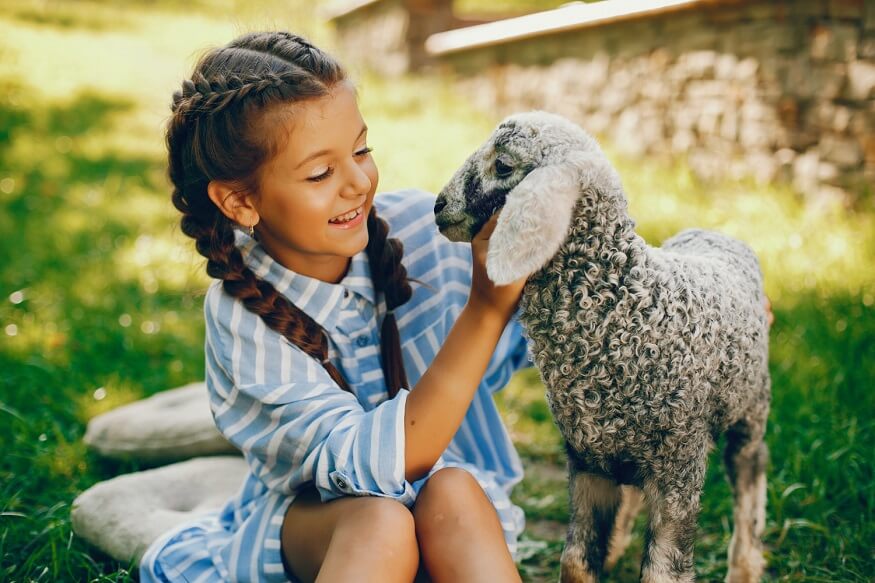Kids love animals, whether they are fluffy dogs, chirping birds, or gentle bunnies. One of the most important relationships for children, in their growing-up years is their connection with animals. Hence it is important to teach kids how to be safe around animals. Understanding how to properly approach or avoid animals can help protect kids from potential dangers. This blog will share some simple animal safety tips to help kids have fun with animals while keeping everyone safe.
Also Read : Electrical safety for kids: The dangers of sockets and appliances
Three key principles
Understanding, respect, and caution are three key principles in promoting animal safety among children.
Understanding animals
Educating children about animal behaviour, how they express their feelings, and understanding how one’s actions might invade their space contributes significantly to animal safety. Kids should learn about different animals, and their signs of distress, happiness, and discomfort.
For instance, most dogs wag their tail when happy. However, a dog with its tail between its legs could be afraid. Educating children about these different behaviours can mitigate potential harm.
Similarly, in the wild, some animals have unique warning signs – like a rattlesnake’s rattle or a porcupine’s quills standing on end. An understanding of these signs can play a pivotal role in ensuring safety.
Respecting animals
Animals, whether domestic or wild, are sentient beings that deserve our respect. When it comes to approaching animals, particular protocols must be followed. Children should never approach an animal they do not know without the owner’s permission or an adult’s presence. This applies to both domestic and wild animals.
When approaching a new pet, let the animal come to the child. A quick movement or an attempt to pet it might provoke it. Animals need their space and time to get accustomed to new people.
Children should learn to approach them calmly, without causing fear or discomfort even with known pets. They should be instructed to avoid approaching a pet that is feeding, sleeping, or nursing its young. It is also essential to discourage kids from petting or holding wild animals. They can indeed be cute but potentially harmful or easily distressed.
Exercising caution
Avoidance is sometimes the best policy when it comes to animals. Children must understand not all animals want to play with them or want their attention. They should avoid animals they do not know, animals with young, large groups of animals, and any animals behaving unusually or aggressively.
While local wildlife can be fascinating, it is crucial to instruct children never to approach or touch wild animals. Even seemingly harmless creatures can carry diseases, cause harm when they feel threatened, or lead to unintended damage to the animal itself. Instead, advise children to admire wildlife from a distance.
Every parent or caregiver should consider teaching their children basic animal emergency skills. This includes learning emergency contact numbers, knowing when and how to seek help, and having a basic understanding of what to do when an animal must be urgently avoided.
When children are taught to observe, understand, and appreciate animals from a safe distance without causing distress or harm to them, it not only guarantees their safety but also promotes a new generation that respects and values all living beings.
Animal safety tips for kids
Here are some handy tips to ensure that your children and animals have a safe and happy relationship.
- Never leave a child unsupervised around animals.
- Always pet an animal gently while respecting its boundaries.
- Do not allow the child to pull or tug at animals especially from behind.
- Avoid making loud sounds or sudden moves when approaching an animal.
- Discourage your child from touching the animal’s eyes, ears, nose or genitals.
- Educate children to avoid contact with animal waste which can cause diseases.
- Do not allow your child to touch an animal during their time of heightened excitement such as while the dog is eating, or playing with their toys.
- Discourage your child from riding any animal
- Teach children to avoid direct eye contact with animals. Staring directly into an animal’s eyes is often perceived as threatening behaviour.
- Teach children to Avoid the face and head area when petting dogs and cats. Stroke along the neck, back, and sides.
- An animal that is growling or hissing must be left alone
- Teach your child not to run when approached by a strange dog. Running may provoke the dog to chase and attack. Stand still until the dog leaves.
Also Read: Toy Safety for Kids
Wild animal safety tips for kids
- Never feed wild animals. Human foods are often inappropriate and unhealthy for wild animals, possibly causing them diseases.
- Observe from a distance. Use binoculars or a camera with a zoom lens for a close-up view
- Leave young wildlife alone. If you find a seemingly lost or abandoned young animal, curb our instinct to ‘rescue’ it. Pet parents often leave their young unsupervised to find food. Picking up these animals can lead to a separation between the young and their parents and can expose the child to diseases
- Do not keep a wild animal as a pet. Wild animals are not meant to live in the domestic environment and can endanger the safety of the child and the animal.
- Do not venture out alone in forest areas. Go in groups under adult supervision.
Also Read : 10 rules for stranger safety
Teaching children about animal safety is not only about protecting them but also about teaching them empathy and respect for all living creatures. By following these guidelines, kids can enjoy their interactions with animals while ensuring a safe and enjoyable experience for both themselves and the animals they encounter.











